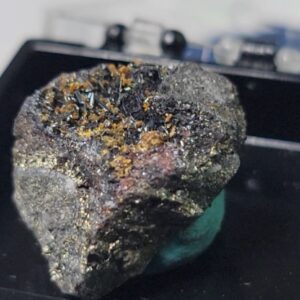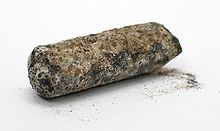Tl – Thallium
products and information
Hutchinsonite from Peru
Parapierrotite
There are ~124 named minerals containing Silver listed on mindat we have yet to add to our shop:
| Amgaite | Tl2+3Te6+O6 | Nataliyamalikite | TlI | Vaughanite | TlHgSb4S7 |
| Arsiccioite | AgHg2Tl(As,Sb)2S6 | Palladothallite | Pd3Tl | Vorontsovite | (Hg5Cu)Σ6TlAs4S12 |
| Auerbakhite | MnTl2As2S5 | Parapierrotite | TlSb5S8 | Vrbaite | Hg3Tl4As8Sb2S20 |
| Avicennite | Tl2O3 | Philrothite | TlAs3S5 | Wallisite | (Cu,Ag)TlPbAs2S5 |
| Bernardite | TlAs5S8 | Picotpaulite | TlFe2S3 | Weissbergite | TlSbS2 |
| Biagioniite | Tl2SbS2 | Pierrotite | Tl2(Sb,As)10S16 | Vaughanite | TlHgSb4S7 |
| Boscardinite | TlPb4(Sb7As2)S18 | Pokhodyashinite | Cu2Tl3Sb5As2S13 | Vorontsovite | (Hg5Cu)Σ6TlAs4S12 |
| Bukovite | Tl2(Cu,Fe)4Se4 | Protochabournéite | Tl4-xPb2+2xSb20-x-yAsyS34 | Vrbaite | Hg3Tl4As8Sb2S20 |
| Carlinite | Tl2S | Raberite | Tl5Ag4As6SbS15 | Wallisite | (Cu,Ag)TlPbAs2S5 |
| Chabournéite | AgzTl8-x-zPb4+2xSb40-x-yAsyS68 | Raguinite | TlFeS2 | Weissbergite | TlSbS2 |
| Chalcothallite | Tl2(Cu,Fe)6SbS4 | Ralphcannonite | AgZn2TlAs2S6 | Vaughanite | TlHgSb4S7 |
| Christite | TlHgAsS3 | Rathite | Ag2Pb12-xTlx/2As18+x/2S40 | Vorontsovite | (Hg5Cu)Σ6TlAs4S12 |
| Chrysothallite | K6Cu6Tl3+Cl17(OH)4 · H2O | Rayite | Pb8(Ag,Tl)2Sb8S21 | Vrbaite | Hg3Tl4As8Sb2S20 |
| Criddleite | TlAg2Au3Sb10S10 | Rebulite | Tl5Sb5As8S22 | Wallisite | (Cu,Ag)TlPbAs2S5 |
| Crookesite | Cu7(Tl, Ag)Se4 | Richardsollyite | TlPbAsS3 | Weissbergite | TlSbS2 |
| Cuprostibite | Cu2(Sb,Tl) | Rohaite | (Tl,Pb,K)2Cu8.7Sb2S4 | Vaughanite | TlHgSb4S7 |
| Dalnegroite | (Tl4Pb2)(As12Sb8)S34 | Routhierite | Tl(Cu,Ag)(Hg,Zn)2(As,Sb)2S6 | Vorontsovite | (Hg5Cu)Σ6TlAs4S12 |
| Dekatriasartorite | TlPb58As97S204 | ‘Routhierite Group’ | Me1+Me222+Tl(As,Sb)2S6 | Vrbaite | Hg3Tl4As8Sb2S20 |
| Dewitite | AgzTl10-x-zPb2xSb42-x-yAsyS68 | Sabatierite | TlCu6Se4 | Wallisite | (Cu,Ag)TlPbAs2S5 |
| Dorallcharite | TlFe33+(SO4)2(OH)6 | Shimenite | Tl5Sb21-yAsyS34 | Weissbergite | TlSbS2 |
| Drechslerite | Tl4(Sb4-xAsx)S8 (1 < x < 2) | Sicherite | TlAg2(As,Sb)3S6 | Vaughanite | TlHgSb4S7 |
| Écrinsite | AgTl3Pb4As11Sb9S36 | Simonite | TlHgAs3S6 | Vorontsovite | (Hg5Cu)Σ6TlAs4S12 |
| Edenharterite | PbTlAs3S6 | Spaltiite | Tl2Cu2As2S5 | Vrbaite | Hg3Tl4As8Sb2S20 |
| Ellisite | Tl3AsS3 | Stalderite | Tl(Cu,Ag)(Zn,Fe,Hg)2(As,Sb)2S6 | Wallisite | (Cu,Ag)TlPbAs2S5 |
| Enneasartorite | Tl6Pb32As70S140 | Steropesite | Tl3BiCl6 | Weissbergite | TlSbS2 |
| Erniggliite | Tl2SnAs2S6 | ‘Stibioellisite’ | Tl3SbS3 | Vaughanite | TlHgSb4S7 |
| Evdokimovite | Tl4(VO)3(SO4)5(H2O)5 | Thalcusite | Tl2Cu3FeS4 | Vorontsovite | (Hg5Cu)Σ6TlAs4S12 |
| Fangite | Tl3AsS4 | Thalfenisite | Tl6(Fe,Ni,Cu)25S26Cl | Vrbaite | Hg3Tl4As8Sb2S20 |
| Ferrostalderite | CuFe2TlAs2S6 | ‘Thallian Voltaite’ | (K,Tl)2Fe52+Fe33+Al(SO4)12 · 18H2O | Wallisite | (Cu,Ag)TlPbAs2S5 |
| Ferrovorontsovite | (Fe5Cu)Σ6TlAs4S12 | Thalliomelane | Tl(Mn4+7.5Cu2+0.5)O16 | Weissbergite | TlSbS2 |
| Gabrielite | Tl6Ag3Cu6(As,Sb)9S21 | ‘Thallium’ | Tl | Vaughanite | TlHgSb4S7 |
| Gillulyite | Tl2As7.5Sb0.3S13 | ‘Tl-, Ar-bearing Pyrite’ | (Fe,Tl)(S,As)2 | Vorontsovite | (Hg5Cu)Σ6TlAs4S12 |
| Gladkovskyite | MnTlAs3S6 | ‘Tl-bearing Al-(K)’ | (K,Tl)Al(SO4)2 · 12H2O | Vrbaite | Hg3Tl4As8Sb2S20 |
| Gungerite | TlAs5Sb4S13 | ‘Tl-bearing Carnotite’ | (K,Tl)2(UO2)2[VO4]2 · 3H2O | Wallisite | (Cu,Ag)TlPbAs2S5 |
| Hatchite | AgTlPbAs2S5 | ‘Tl-bearing Cryptomelane’ | (K,Tl)(Mn74+Mn3+)O16 | Weissbergite | TlSbS2 |
| Hendekasartorite | Tl2Pb48As82S172 | ‘Tl-bearing Murunskite’ | (K,Tl)2Cu3FeS4 | Vaughanite | TlHgSb4S7 |
| Hephaistosite | TlPb2Cl5 | Thalliumpharmacosiderite | TlFe4[(AsO4)3(OH)4] · 4H2O | Vorontsovite | (Hg5Cu)Σ6TlAs4S12 |
| Heptasartorite | Tl7Pb22As55S108 | Thunderbayite | TlAg3Au3Sb7S6 | Vrbaite | Hg3Tl4As8Sb2S20 |
| Honeaite | Au3TlTe2 | Tsygankoite | Mn8Tl8Hg2(Sb21Pb2Tl)S48 | Wallisite | (Cu,Ag)TlPbAs2S5 |
|
(Hutchinsonite) |
TlPbAs5S9 | Twinnite | Pb0.8Tl0.1Sb1.3As0.8S4 | Weissbergite | TlSbS2 |
| Imhofite | Tl5.8As15.4S26 | ‘UM1970-20-S:AsSbTl’ | Tl(As,Sb)10S16 | Vaughanite | TlHgSb4S7 |
| Incomsartorite | Tl6Pb144As246S516 | ‘UM1976-20-S:SbTl’ | TlSb11S17 | Vorontsovite | (Hg5Cu)Σ6TlAs4S12 |
| Jankovićite | Tl5Sb9(As,Sb)4S22 | ‘UM1982-10-S:AsSbTl’ | Tl(Sb,As)7S11 | Vrbaite | Hg3Tl4As8Sb2S20 |
| Jentschite | TlPbAs2SbS6 | ‘UM1991-16-S:CuFeTl’ | (Cu,Tl,Ag)FeS2 | Wallisite | (Cu,Ag)TlPbAs2S5 |
| Kalithallite | K3Tl3+Cl6 · 2H2O | ‘UM1993-13-S:BiCuTl’ | (Cu,Fe,Tl)2Bi2S5 | Weissbergite | TlSbS2 |
| Karpovite | Tl2VO(SO4)2(H2O) | ‘UM1993-27-Te:AuTl’ | Au3TlTe2 | Vaughanite | TlHgSb4S7 |
| Lafossaite | Tl(Cl,Br) | ‘UM1994-01-AsO:FeHSTl’ | Fe2TlAs3O12 · 4H2O | Vorontsovite | (Hg5Cu)Σ6TlAs4S12 |
| Lanmuchangite | Tl+Al(SO4)2 · 12H2O | ‘UM1997-41-S:CuFeKNiPbTl’ | (K,Tl,Pb)6(Fe,Cu,Ni)25S27 | Vrbaite | Hg3Tl4As8Sb2S20 |
| Lorándite | TlAsS2 | ‘UM1998-03-Cl:Tl’ | TlCl | Wallisite | (Cu,Ag)TlPbAs2S5 |
| Markhininite | TlBi(SO4)2 | ‘UM1999-20-S:AgAsPbSbTl’ | (Tl,Ag)2Pb6(As,Sb)16S31 | Weissbergite | TlSbS2 |
From Wikipedia:
Chemists William Crookes and Claude-Auguste Lamy discovered thallium independently in 1861, in residues of sulfuric acid production. Both used the newly developed method of flame spectroscopy, in which thallium produces a notable green spectral line. Thallium, from Greek θαλλός, thallós, meaning “green shoot” or “twig”, was named by Crookes. It was isolated by both Lamy and Crookes in 1862; Lamy by electrolysis, and Crookes by precipitation and melting of the resultant powder. Crookes exhibited it as a powder precipitated by zinc at the international exhibition, which opened on 1 May that year. The odorless and tasteless thallium sulfate was once widely used as rat poison and ant killer. Since 1972 this use has been prohibited in the United States due to safety concerns. Many other countries followed this example. Thallium salts were used in the treatment of ringworm, other skin infections and to reduce the night sweating of tuberculosis patients. This use has been limited due to their narrow therapeutic index, and the development of improved medicines for these conditions.
According to wikipedia –
Optics
Thallium(I) bromide and thallium(I) iodide crystals have been used as infrared optical materials, because they are harder than other common infrared optics, and because they have transmission at significantly longer wavelengths. The trade name KRS-5 refers to this material.[46] Thallium(I) oxide has been used to manufacture glasses that have a high index of refraction. Combined with sulfur or selenium and arsenic, thallium has been used in the production of high-density glasses that have low melting points in the range of 125 and 150 Celsius|°. These glasses have room-temperature properties that are similar to ordinary glasses and are durable, insoluble in water and have unique refractive indices.[47]
Electronics
Thallium(I) sulfide’s electrical conductivity changes with exposure to infrared light, making this compound useful in photoresistors.[43] Thallium selenide has been used in bolometers for infrared detection.[48] Doping selenium semiconductors with thallium improves their performance, thus it is used in trace amounts in selenium rectifiers.[43] Another application of thallium doping is the sodium iodide crystals in gamma radiation detection devices. In these, the sodium iodide crystals are doped with a small amount of thallium to improve their efficiency as scintillation generators.[49] Some of the electrodes in dissolved oxygen analyzers contain thallium.[6]
High-temperature superconductivity
Research activity with thallium is ongoing to develop high-temperature superconducting materials for such applications as magnetic resonance imaging, storage of magnetic energy, magnetic propulsion, and electric power generation and transmission. The research in applications started after the discovery of the first thallium barium calcium copper oxide superconductor in 1988.[50] Thallium cuprate superconductors have been discovered that have transition temperatures above 120 K. Some mercury-doped thallium-cuprate superconductors have transition temperatures above 130 K at ambient pressure, nearly as high as the world-record-holding mercury cuprates.[51]
Nuclear medicine
Before the widespread application of technetium-99m in nuclear medicine, the radioactive isotope thallium-201, with a half-life of 73 hours, was the main substance for nuclear cardiography. The nuclide is still used for stress tests for risk stratification in patients with coronary artery disease (CAD).[52] This isotope of thallium can be generated using a transportable generator, which is similar to the technetium-99m generator.[53] The generator contains lead-201 (half-life 9.33 hours), which decays by electron capture to thallium-201. The lead-201 can be produced in a cyclotron by the bombardment of thallium with protons or deuterons by the (p,3n) and (d,4n) reactions.[54][55]
Thallium stress test
A thallium stress test is a form of scintigraphy in which the amount of thallium in tissues correlates with tissue blood supply. Viable cardiac cells have normal Na+/K+ ion-exchange pumps. The Tl+ cation binds the K+ pumps and is transported into the cells. Exercise or dipyridamole induces widening (vasodilation) of arteries in the body. This produces coronary steal by areas where arteries are maximally dilated. Areas of infarct or ischemic tissue will remain “cold”. Pre- and post-stress thallium may indicate areas that will benefit from myocardial revascularization. Redistribution indicates the existence of coronary steal and the presence of ischemic coronary artery disease.[56]
Other uses
A mercury–thallium alloy, which forms a eutectic at 8.5% thallium, is reported to freeze at −60 °C, some 20 °C below the freezing point of mercury. This alloy is used in thermometers and low-temperature switches.[43] In organic synthesis, thallium(III) salts, as thallium trinitrate or triacetate, are useful reagents for performing different transformations in aromatics, ketones and olefins, among others.[57] Thallium is a constituent of the alloy in the anode plates of magnesium seawater batteries.[6] Soluble thallium salts are added to gold plating baths to increase the speed of plating and to reduce grain size within the gold layer.[58]
A saturated solution of equal parts of thallium(I) formate (Tl(CHO2)) and thallium(I) malonate (Tl(C3H3O4)) in water is known as Clerici solution. It is a mobile, odorless liquid which changes from yellowish to colorless upon reducing the concentration of the thallium salts. With a density of 4.25 g/cm3 at 20 °C, Clerici solution is one of the heaviest aqueous solutions known. It was used in the 20th century for measuring the density of minerals by the flotation method, but its use has discontinued due to the high toxicity and corrosiveness of the solution.[59][60]
Thallium iodide is frequently used as an additive in metal-halide lamps, often together with one or two halides of other metals. It allows optimization of the lamp temperature and color rendering,[61][62] and shifts the spectral output to the green region, which is useful for underwater lighting
From Wikipedia:
| Hazards | |
|---|---|
| GHS labelling: | |
   |
|
| Danger | |
| H300, H330, H373, H413 | |
| P260, P264, P284, P301, P310[64] | |
| NFPA 704 (fire diamond) |
|
Thallium and its compounds are extremely toxic, with numerous recorded cases of fatal thallium poisoning.[65][66] The Occupational Safety and Health Administration (OSHA) has set the legal limit (permissible exposure limit) for thallium exposure in the workplace as 0.1 mg/m2 skin exposure over an eight-hour workday. The National Institute for Occupational Safety and Health (NIOSH) also set a recommended exposure limit (REL) of 0.1 mg/m2 skin exposure over an eight-hour workday. At levels of 15 mg/m2, thallium is immediately dangerous to life and health.[67]
Contact with skin is dangerous, and adequate ventilation is necessary when melting this metal. Thallium(I) compounds have a high aqueous solubility and are readily absorbed through the skin, and care should be taken to avoid this route of exposure, as cutaneous absorption can exceed the absorbed dose received by inhalation at the permissible exposure limit (PEL).[68] Exposure by inhalation cannot safely exceed 0.1 mg/m2 in an eight-hour time-weighted average (40-hour work week).[69] The Centers for Disease Control and Prevention (CDC) states, “Thallium is not classifiable as a carcinogen, and it is not suspected to be a carcinogen. It is unknown whether chronic or repeated exposure to thallium increases the risk of reproductive toxicity or developmental toxicity. Chronic high level exposure to thallium through inhalation has been reported to cause nervous system effects, such as numbness of fingers and toes.”[70] For a long time thallium compounds were readily available as rat poison. This fact and that it is water-soluble and nearly tasteless led to frequent intoxication caused by accident or criminal intent.[33]
One of the main methods of removing thallium (both radioactive and stable) from humans is to use Prussian blue, a material which absorbs thallium.[71] Up to 20 grams per day of Prussian blue is fed by mouth to the patient, and it passes through their digestive system and comes out in their stool. Hemodialysis and hemoperfusion are also used to remove thallium from the blood serum. At later stages of the treatment, additional potassium is used to mobilize thallium from the tissues.[72][73]
According to the United States Environmental Protection Agency (EPA), artificially-made sources of thallium pollution include gaseous emission of cement factories, coal-burning power plants, and metal sewers. The main source of elevated thallium concentrations in water is the leaching of thallium from ore processing operations.[37][74]
Thallium has pretty much been found everywhere:






